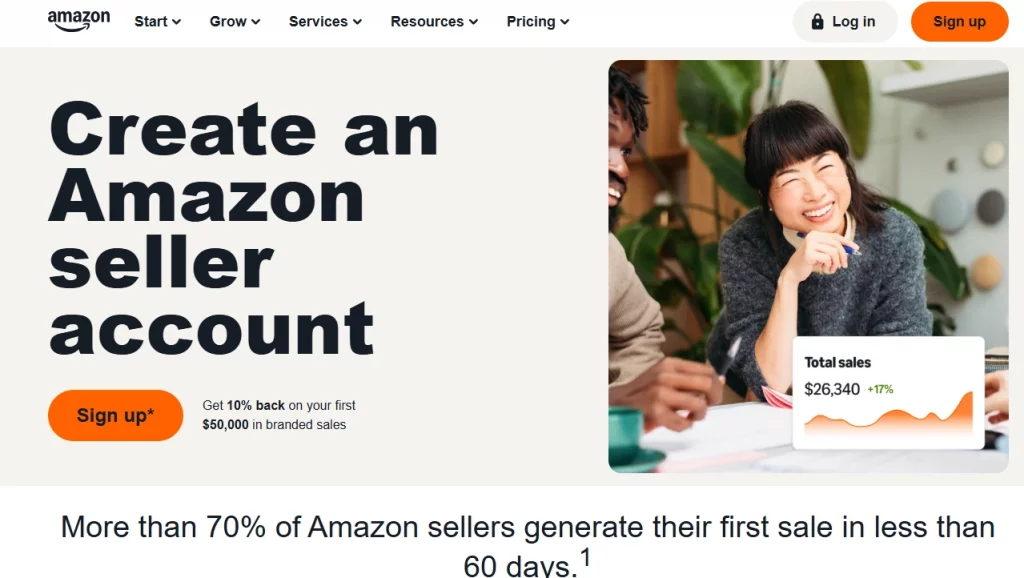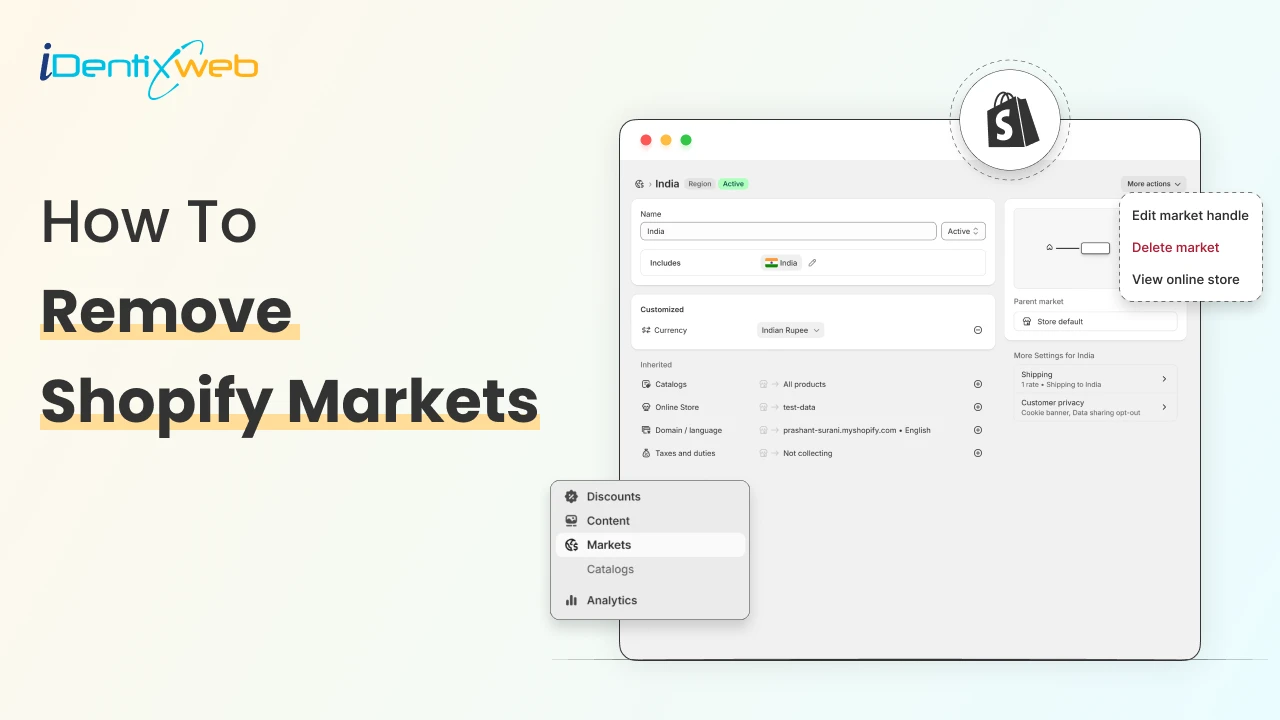
It’s 2014, and Faisal was struggling with twins and a passion for sustainable food products. Every baby utensil was made with plastic and chemicals. He started Ananchy, a successful store, to create sustainable dishes that are good for children and the planet. We will talk more about Avanchy later in this article.
The important thing is that Faisal chose Shopify over Amazon for his e-commerce business. But that's just one business owner. The choice between Shopify and Amazon depends on your business goals.
Shopify vs Amazon is a key decision that every e-commerce entrepreneur faces today. In this article, we will break down Shopify and Amazon to help you choose the best e-commerce platform between the two.
Let’s start by understanding the common differences between these e-commerce giants.
Shopify vs Amazon: The Common Differences
Both platforms offer huge opportunities, but they each come with their own set of advantages and challenges. The biggest difference between Shopify and Amazon is that Shopify is an ecommerce platform and Amazon is an online marketplace. On Amazon, sellers often need to consider the Amazon Vendor vs. Seller Central model to determine which works best for their business needs.
An e-commerce platform lets you build your own branded online store with full control over design, pricing, and customer experience. Online marketplaces are where you sell alongside other businesses, and much of the customer experience is controlled by the marketplace itself.
The core differences between the two platforms are listed below:
Shopify vs Amazon: The Comparison
| Feature | Shopify | Amazon |
| Platform Type | E-commerce platform to create your own store | Online marketplace to sell alongside other sellers |
| Control Over Branding | Full control over branding, design, and customer experience | Limited control over branding and appearance |
| Fees | Monthly subscription fee + transaction fees | Listing fees + referral fees + FBA (Fulfillment by Amazon) fees |
| Product Listings | Fully customizable product pages | Product listings follow Amazon’s standardized format |
| Logistics | Manage your own logistics or use third-party fulfillment services | Use Amazon FBA for fulfillment and shipping |
| Market Reach | You build your own customer base | Instant access to Amazon’s massive global customer base |
| Scalability | Easily scalable with various plans, apps, and integrations | Scalable within Amazon’s marketplace, but with increasing competition |
| Support | 24/7 support with access to forums and tutorials | Seller support can be challenging to navigate |
| Customization Options | High flexibility with themes, apps, and code | Limited customization within the marketplace's framework |
| Global Reach | Requires extra effort for global expansion (shipping, taxes, etc.) | Instant global reach with dedicated international marketplaces |
Thinking about the pricing plans between the two? Let’s understand both platforms’ pricing plans.
Shopify vs Amazon: Pricing
When it comes to costs and fees, both Shopify and Amazon have their own structures that can impact your overall expenses. Here's a breakdown of the fees you can expect for each platform:
Shopify Pricing
Shopify offers four tiers of subscription plans:
Subscription Fees:
- Basic Plan: $29/month
- Grow Plan: $79/month
- Advanced Plan: $299/month
- Shopify Plus (enterprise-level): Starting at $2,000/month
Apart from the subscription fees, there are many other types of fees for online merchants who use Shopify.
Transaction Fees
A fee Shopify charges for each sale made through the platform, based on the plan you choose. The transaction fee applies to sales processed through Shopify Payments or third-party payment gateways.
Credit Card Fees
These are fees associated with processing payments made via credit card through Shopify Payments. The fee allows the merchant to accept major credit cards such as Visa or MasterCard.
App & Add-on Fees
Many Shopify apps offer additional features or integrations that are essential for running your store, such as marketing tools, customer support, and reporting. These apps usually come with their own subscription fees.
Shipping Costs:
You are responsible for shipping unless you use Shopify's discounted shipping rates or integrate third-party logistics services.
Here’s a complete list of articles on payments related to a Shopify store. Read each article carefully to understand the fee required to run your business on Shopify.
Amazon Pricing
Amazon offers two tiers of subscription fees:
Subscription Fees:
- Individual Plan: No monthly fee, but you pay $0.99 per item sold. This plan is ideal for sellers with fewer products.
- Professional Plan: $39.99/month (no per-item fee). This is recommended for serious sellers or those with a large inventory.
There are also many other fees included in the Amazon pricing for merchants. The most common fees are listed below:
Referral Fees
A percentage of the sale price Amazon takes for every product sold on its marketplace. This fee varies depending on the product category.
Fulfillment Fees (FBA)
Fees associated with using Amazon’s Fulfillment by Amazon (FBA) service. This covers the cost of storing, packing, and shipping products from Amazon’s warehouses.
Storage Fees
Amazon charges for storing inventory in its warehouses. The fees depend on the space your products occupy and the time of year.
Advertising Fees
Fees for running ads on Amazon's platform to promote your products. This includes options like sponsored products or other ad placements within the Amazon marketplace.
Refund Administration Fee
A fee Amazon charges to cover the processing of customer returns and refunds.
Here’s a list of every fee Amazon levies on sellers. Read the related article closely to understand the costs associated with running a store on Amazon.
How to Choose the Best E-commerce Platform? Amazon vs Shopify
When deciding between Shopify vs Amazon, it comes down to your business goals and how much control you want over your store.
Let’s break it down.
Why Choose Amazon Marketplace?

- Instant access to a huge audience: Amazon gives you access to millions of potential customers right from the start. This is the best ecommerce platform if you're looking to hit the ground running.
- Easy logistics with FBA: Amazon's Fulfillment by Amazon (FBA) takes care of storing, packing, and shipping, which can save you a lot of time and hassle.
- Trust factor: People trust Amazon, so you don’t have to work as hard for branding to prove your credibility.
Amazon Drawbacks
- Limited control over branding: You don’t get to customize your store as much, and your products will be listed next to your competitors.
- Fees add up: From referral fees to FBA costs, Amazon’s fees can eat into your profits.
- Intense competition: Standing out on Amazon can be tough with so many sellers in your category.
Why Choose Shopify E-commerce Platform?

Complete control over branding: This is the best ecommerce platform if you want to create a unique store that reflects your brand. You own the shopping experience of your store. You have full control over your pricing, store design customization, and customer service.
- Scalable and customizable: As your business grows, Shopify scales with you. You can add new features with apps and integrations. I would suggest Shopify as the best ecommerce platform for small businesses.
- Shopify app store: Shopify offers powerful apps to help with different processes within your store. For example, iCart, Cart drawer Cart Upsell for upselling, and Stellar Delivery Date and Pickup for streamlined delivery management. Apps like iCart help Shopify merchants increase AOV by providing smart pre-purchase upsell features.
When Faisal contacted us to increase their sales, iCart Cart Drawer Cart Upsell, our Shopify app helped Avanchy increase its revenue by 73%. iCart helps merchants create sticky cart drawers. It enhances the UX by providing easy access to the cart for the customer. This simplifies and streamlines the checkout process.
- Customizable Shopify themes: Shopify offers a wide variety of paid and free Shopify themes, which you can fully customize to match your brand's personality. This allows you to create a unique, professional-looking store without needing extensive design skills.
Shopify Drawbacks
- More effort for traffic: Unlike Amazon, you’ll need to drive traffic to your store through SEO, ads, or social media.
- Subscription fees: Shopify charges a monthly fee, which can be a challenge for new businesses.
- Logistics are on you: You’ll need to manage shipping or partner with fulfillment services.
Bottom Line: Shopify vs Amazon, Which One Should You Choose?
So, Shopify vs. Amazon, which one’s the better choice for online store success?
If you want complete control over your brand, store design customization, and CX, Shopify is probably the way to go. It lets you build a unique Shopify store with apps and themes to help you scale and manage easily.
But if you're after quick access to a huge customer base and prefer a platform that handles the logistics, selling on Amazon might be the right fit.
It comes down to your priorities. Shopify vs Amazon is a question many new business owners face, each with its unique set of advantages and challenges. Choose a solution that aligns with your goals.
Shopify vs Amazon FAQs
1. Can I link my Shopify store to Amazon?
Yes, you can link your Shopify store to Amazon using the Amazon MCF buy with Prime app, which allows you to list and manage your products on Amazon from your Shopify dashboard. This enables you to expand your reach by selling on both platforms.
2. Which is the best ecommerce platform for SEO?
Shopify offers robust SEO features, including customizable meta tags, sitemaps, and app integrations for better optimization. Read this Shopify SEO manual to improve your Shopify store’s visibility.
3. What is the difference between Amazon and Shopify?
Shopify is an e-commerce platform that provides merchants with their own store with full control over design, pricing, and CX. Amazon is an online marketplace where you can sell alongside other merchants with limited control over CX.
4. How does Shopify pricing work?
Shopify offers tiered subscription plans. Each plan comes with different features and transaction fees. Additional costs include payment gateway fees, apps, and themes, depending on your store's needs. Click here to get complete details regarding Shopify plans.
5. Is Shopify better than Amazon?
If you're wondering whether to go with Shopify vs Amazon, think about your long-term business goals. If you're looking to build a unique brand, Shopify is ideal; for broader reach with less effort, Amazon works well.




![Shopify Launches Winter 2026 Edition: RenAIssance [Key Updates Explained] Shopify Launches Winter 2026 Edition: RenAIssance [Key Updates Explained]](https://www.identixweb.com/wp-content/uploads/2025/12/11-12-Thu-Blog-Shopify-Launches-Winter-26-Edition_-RenAIssance-1.webp)

About the author
Vineet Nair
Vineet is an experienced content strategist with expertise in the ecommerce domain and a keen interest in Shopify. He aims to help Shopify merchants thrive in this competitive environment with technical solutions and thoughtfully structured content.